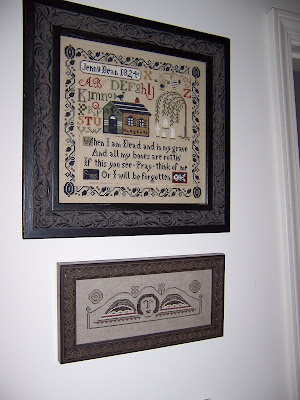Stacy Nash Cherry Hollow Farm
Limited Edition Kit released through Norden Nashville Needlework Market 2015
Linen is Weeks 36 count Beige
Threads Weeks Overdyed
I have taken liberties with Stacy's design. Stacy stitched her vine with Cocoa, mine is stitched with Weeks Kudzu.
When Grandmother Bessie and her family moved to the farm (Flowing Water) in 1949, the farm had been neglected and needed work and diligent attention. With hard work, sacrifice and good management the family turned an overgrown neglected piece of land into a sustainable farm. Grandmother would often talk about the vine which was growing wildly and her family (men, women and children) spent many hours removing this vine. I don't remember that Grandmother called this vine by name she just always referred to it as "the vine."
Kudzu also called Japanese arrowroot and is referred to "as the vine that ate the South." It grows up to one foot per day and covers a quarter million acres in Alabama and seven million acres across the Southeastern United States. Kudzu was first introduced to the United States in 1896 as an ornamental bush. In the 1940's and 1950's, Kudzu was rebranded as a way for farmers to stop soil erosion. Kudzu blossoms are used to make jellies and jams and the vine is used for grazing animals, fiber art and basketry. Engineers at the University of Alabama are studying the possibility of turning the vine into ethanol.
Grandmother Bessie never called the vine Kudzu, she just knew there was an invasive vine growing on the farm which had to be eradicated.
One of the many things which attract me to Stacy Nash's design are the borders. The vine on this border is a delight to stitch and is making the design come alive.
Kudzu also called Japanese arrowroot and is referred to "as the vine that ate the South." It grows up to one foot per day and covers a quarter million acres in Alabama and seven million acres across the Southeastern United States. Kudzu was first introduced to the United States in 1896 as an ornamental bush. In the 1940's and 1950's, Kudzu was rebranded as a way for farmers to stop soil erosion. Kudzu blossoms are used to make jellies and jams and the vine is used for grazing animals, fiber art and basketry. Engineers at the University of Alabama are studying the possibility of turning the vine into ethanol.
Grandmother Bessie never called the vine Kudzu, she just knew there was an invasive vine growing on the farm which had to be eradicated.
One of the many things which attract me to Stacy Nash's design are the borders. The vine on this border is a delight to stitch and is making the design come alive.


























